Between the Years When the Oceans Drank (Henry Kuttner’s) Atlantis, and the Rise of COVID-19 — Elak Lives Again!
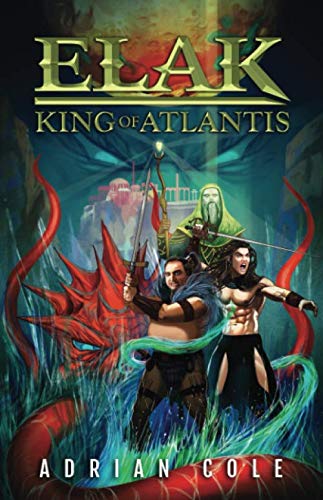
Adrian Cole is hardly a stranger to fantasy fiction.
Born in Plymouth, Devonshire in 1949, Adrian first read The Lord of the Rings in the late 1960s while working in a public library in Birmingham, and was inspired by the book to write an epic entitled “The Barbarians,” which was eventually revised into The Dream Lords trilogy, published by Zebra Books in the early 1970s. He has been writing various ghost, horror, and fantasy tales, in both short-story and novel-length, ever since. His career is well-established and diverse, from psychological, alien-horror, to superheroes, fantasy trilogies to young-adult novels.
So it is particularly interesting that Adrian’s newest work is an anthology of stories about the adventurer Elak of Atlantis: Elak, King of Atlantis, which was just released earlier this month by Pulp Hero Press.
Atlantis? A vogue setting in early to mid-20th century fantasy fiction, we don’t really see novels or short stories in Atlantis anymore. Ah, but you see, Elak is himself a piece of history…
After Robert E. Howard’s unfortunate suicide in 1936, a number of authors stepped up to fill the void. Most wrote reasonable, working tales, that were largely forgettable, and they themselves were forgotten. One, however, was the masterful Henry Kuttner, who danced easily between fantasy, horror and science fiction, and had a stellar career, made the more so by his collaborations with his wife, C. L. Moore. Kuttner wrote four Elak of Atlantis stories, which appeared in Weird Tales between 1938 and 1940. They are an abridged version of REH’s Conan stories, and follow the exploits of Elak as he passes from sword-for-hire to king. But Elak is not a “Clonan”: he’s a civilized man, a noble cast-off, who wields a rapier. Whereas Conan is destined to seize a crown, Elak is trying to avoid his destiny. Unlike Conan, he is not a loner with “guest star” companions, and is accompanied by the perpetually drunk thief Lycon, and the druid Dalan, who is trying to get Elak to accept his destiny to rule the kingdom of Cyrena.
We first meet Elak returning from an encounter with the wife of Atlantean nobility and that strikes a note in the tales: there is a light-heartedness to them, although the world is a dark one. If you can imagine an Errol Flynn swashbuckler with wizards and Deep Ones, you have the vibe.
Of course, that doesn’t tell us why, 80 years after Kuttner abandoned the doomed island, Cole is bringing it back up from its watery depths.
So, Adrian, why Elak of Atlantis? Kuttner, who went on to write for decades, only wrote four stories and then set the character aside. Other than a Paizo reprint, Elak’s been binned for the better part of 80 years! What about this character reached out to you and said: His time has come?
It was Robert M Price who had the idea of bringing Elak back to life, when he re-launched Strange Tales, once a “sister” mag to Weird Tales. He asked me if I’d like to write a brand new Elak yarn and I thought it would be fun. I’d written a fair bit of sword and sorcery and was/am a big fan of Robert E Howard and had enjoyed Kuttner’s take on that kind of swashbuckling hero. I assumed at the time it would be a one-off and happily set to work.
Bob liked the story very much (and I recall him saying it reminded him of something he would have read in one of the old Lancer paperbacks – they did the Conans, as well as quite a few other S and S novels and collections.) As time went on, Bob asked me for more Elak, and it was always a great opportunity to let off steam, so I duly obliged, until, before I knew it, I had almost enough material for a collection. By then I’d plunged into the Atlantean seas with a will and was more than happy to round off the first arc and King of Atlantis was born.
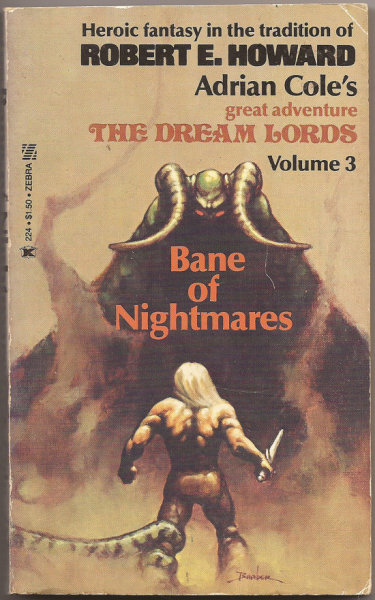 I’ve read before that you actually came to Howard and old-school Sword & Sorcery after publishing The Dream Lords (your first trilogy) in the mid-70s. Is that true?
I’ve read before that you actually came to Howard and old-school Sword & Sorcery after publishing The Dream Lords (your first trilogy) in the mid-70s. Is that true?
Yes! I think I may have started on REH and others like him around about the time I was writing the third Dream Lord book (Bane of Nightmares). So it’s ironic that the publishers, Zebra of NY, splashed REH and Conan all over the covers (as well as Tolkien and Lovecraft, who I had read and been influenced by). Dream Lords was mainly influenced by LOTR, ERB and Dennis Wheatley’s black magic books, but not by any S and S. Incidentally, these books are to be re-released by Pulp Hero Press in the near future, with brand new introductions by me and a fourth volume that collects all the new yarns I’ve had published recently (mostly in Cirsova Magazine).
It’s been a long time since I read TDL but I remember it being sort of like Philip K. Dick writing sword and planet, but even there, it had the swift pacing and the blurring of fantasy and horror I associate with Sword & Sorcery. Were you aware of Kuttner back then, or was he a later discovery, too?
No, I had hardly read anyone in the fantastic adventure field other than classic writers like ERB, Rider Haggard and a few swashbucklers like Frank Yerby, Sabatini and F van Wyk Mason. I had no idea what was waiting in the wings! It was a long time later that I started reading Dick, by the way, and I did become a big fan of his writing (and the movies, of course).
Once you got rolling with S&S you never looked back. What is it about 30’s pulp-style Sword & Sorcery and its revivals that calls to you? This sort of fantasy is decidedly not in vogue right now, and in some cases is even treated with open hostility as being inherently racist, sexist or stereotyping. (Ironically, many of those same people cheerfully read George RR Martin or “Grimdark” fantasy which does any and all of the same things in spades, just with a modern voice.) How should we read old-school Sword & Sorcery as people today? As writers, how do we write it?
You can see from the kind of stuff I enjoyed that I had a real penchant for old fashioned storytelling and adventure. I was also a big fan of horror fiction, having been around when British publisher Pan started doing their regular series. The first few volumes of these were mostly reprints from the classic age of the pulps and I loved that old school stuff. Sure, they were “politically incorrect” but none of that ever really occurred to me at the time. I was too busy enjoying the action, intrigue and fast-paced plots, monsters and battles, etc.
I can certainly understand why the old pulp stuff is considered out of order in these so-called enlightened days, but for me nothing takes away the ability of those writers to tell a skillful yarn in an exciting way – they gave their readers great value for money and their brand of entertainment was generally a huge tonic for the fans in difficult times. My own view is that many of the writers were maybe a little naive in the way they depicted the worlds they created, mirroring the often casual or ignorant attitudes of their own world, and however distasteful it may seem to us now, in the main it wasn’t intended to be offensive or discriminatory, at least, not in a vicious way. You can argue that ignorance is no excuse, but the world was a different place and it is taking a long time to bring a better understanding to it.
Reading old school pulp, sword and sorcery included, can still be fun, but we need to understand the context in which it was set. For some, that will not be enough to warrant giving it house room, which is fair enough. But for me it would be a shame to throw out the baby with the bathwater. I don’t consider myself sexist, racist or any of the other unsavory “ists” but I can still read the old pulp stuff and enjoy its better qualities, especially the amazing story-telling skills. I’m a big fan of Mickey Spillane’s hard-boiled stuff, but I can understand why anyone would go nuts at the very suggestion.
As for writing pulp, well, I try to do it in an acceptable way, that is by telling a good yarn, with maybe a few unexpected twists, possibly set in similar worlds to the old stuff (as with Elak) but without the thoughtless prejudices of the pulp period. I go for plot, dialogue and atmosphere, and you can do that without having to resort to sleaze, or gratuitousness, and if you can capture the spirit and sense of fun, so much the better.
I really think this is the key: the pulps had to seize the audience and keep them, and developed a style of fast-paced writing, love of the exotic and a combination of wide-eyed naivete and tongue-in-cheek that we could use today. You can keep all of that and leave the blatant stereo-typing behind and still have some damn fine writing! Indeed, you do that seamlessly with your Elak stories – they both easily read as a continuation of what came before, yet without anything that modern readers find “problematic”.
You also edited (with Robert Price) and wrote the foreword to a collection of Lin Carter‘s short stories about Thongor of Lemuria: Young Thongor. Carter has a complicated fandom, beloved as an editor (especially for the Ballantine Essentials series), sometimes treated with eyerolls as an author. Clearly, you think there’s more to him.
I read Thongor before any other S & S – mainly because the books were available here in the UK before anything else in that vein, followed by Moorcock’s vast output and then REH. I recognized the ERB influences in Thongor and enjoyed the series because I’d not known about all the other stuff. I went on to read most of Carter’s stuff, being an avid collector at the time of anything remotely pulpish and with a sword on the cover.
As time went on, I realized that Carter specialized in pastiche work (and I’d become familiar with all of the originals that he used – REH, Vance, ERB repeatedly, etc). I used to do a “reading” at the British annual Fantasycon in the 70s, and one time I did a send-up of Carter, Longbore the Inexhaustible. (Subsequently published as a British Fantasy Society booklet and now something of a rarity).
This was meant as a bit of fun and not at all designed to pour scorn on Carter but reflecting on it in later years it struck me that it had been more than a little churlish of me. He was, as you mention, much respected as an editor (and quite rightly so) and he even included me in one of his Year’s Best Fantasy volumes, praising my work. So, when I had an opportunity to do the Young Thongor volume (which for the first time completes the Thongor saga as written by Carter) it was my way of showing him a little respect. The Thongor stories and novels are what they are, but whatever else, they are fun, written with a genuine love of the genre.
I have to admit, I find some of Carter unreadable, but at other items (for example his Green Star series), his love of what he is doing is so pure, it’s, well… endearing.
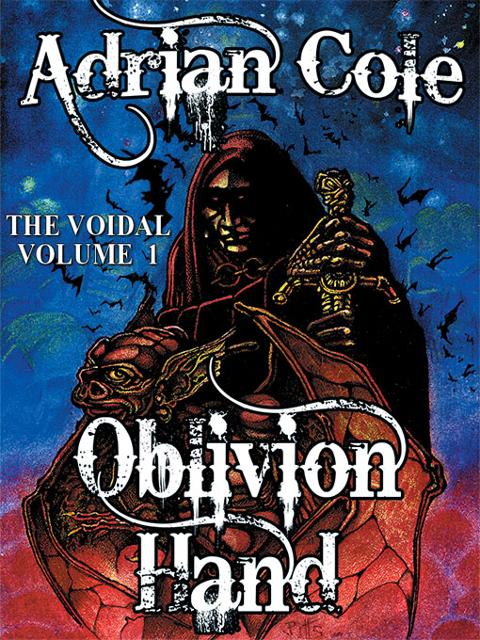 Last year I decided to do a reread and fill in some gaps of my own with a number of classic old-school writers: Kuttner, Leigh Brackett and Jack Vance among them. What amazes me, is how tight and spare these writers were: they built entire civilizations, alien planets, vast counter-histories – in 70k words. That carried over to the next generation, writers like Moorcock or Farmer, but increasingly, we live in the era of 600 – 1,000 page fantasy epics, where the world building dwarfs the story. Howard Andrew Jones says you are one of the few writers active today who can tell a grand epic full of weird wonders and horrors in a short space, a skill of which I am decidedly jealous. Can you tell me a little about your method of world-building: when creating a place for your stories what do you feel the key things the audience needs to understand and “believe”? When does it become too much?
Last year I decided to do a reread and fill in some gaps of my own with a number of classic old-school writers: Kuttner, Leigh Brackett and Jack Vance among them. What amazes me, is how tight and spare these writers were: they built entire civilizations, alien planets, vast counter-histories – in 70k words. That carried over to the next generation, writers like Moorcock or Farmer, but increasingly, we live in the era of 600 – 1,000 page fantasy epics, where the world building dwarfs the story. Howard Andrew Jones says you are one of the few writers active today who can tell a grand epic full of weird wonders and horrors in a short space, a skill of which I am decidedly jealous. Can you tell me a little about your method of world-building: when creating a place for your stories what do you feel the key things the audience needs to understand and “believe”? When does it become too much?
A key factor in all these stories is the imagination of the writers. The old saying about the “suspension of disbelief” very much comes into play, and if as a writer you can apply this effectively and convincingly, you could be innovative and interesting. From my reading of S and S over the years, it’s plain that many writers take the basic concepts they admire (let’s say, for example, Conan himself) and build everything around more of the same, and this just becomes progressively more diluted and repetitive as the pastiches pile up. I like to explore a world’s environment – the more weird and wonderful the better.
This is especially true of my Voidal stories, in which I’ve created entire mini-universes with their own bizarre characteristics. I wanted those stories to be as way out and grotesque as I could make them precisely because I wanted to break out from formulaic S and S. So, for example, you have the Universe of Islands complete with a whole range of outrageous islands, some living organisms, and the Skullworks, a monstrous head (is it?) of a god, and so on.
The danger is that you can get too immersed in building the worlds/settings and not pay enough attention to the characters and the plot. The trick is to blend them all together. The Voidal stories have been revised extensively over 40 years, so hopefully I’ve beaten them into an acceptable state. In my Dream Lords books (the first stuff I wrote) I had a couple of notebooks and I designed the entire system of worlds in which the stories are set. I drew maps, even monsters, and set up whole histories and timelines. It enabled me to have a clear understanding of the background for the “epic”. It may sound a bit boring, but however you plan your work, it is vitally important to know its depths and dimensions. And for me, this sort of creativity is fun! (“Fun” is a word you’ll hear a lot from me. It’s the plasma of my work.)
When I wrote the Omaran Saga, I again initially planned out the world settings carefully, and the chronology, peoples, etc. It was a huge help when I got down to organizing the plots and sub plots. I understand what you mean about the contemporary predilection for world-building dwarfing everything else – for me, Tolkien was one of the very few who got that absolutely right. He immerses you in Middle Earth in a totally convincing way and you don’t actually mind being sidetracked by all the fabulous references to its history and people. He keeps the action flowing, coupled with that sense of dread that hangs over things.
Few writers can do that — possibly part of it is to do with the fact that Tolkien locks into the old Celtic and Norse mythologies and histories, which we identify with, even if it’s only in a subliminal way. I’ve used a sort of pseudo-Celtic background to Omara, mainly because it’s such a fertile area. (And with my part-Irish ancestry, there’s a fair bit of Celt in me, although my wife, Judy, often reminds me that the “Celts” didn’t exist… well not under that name, anyway!)
I think it helps me to have read so widely in the pulp, especially S and S genres. I think the very best of it is has come from REH, Fritz Leiber, Jack Vance, Michael Shea, Moorcock and Zelazny. Their material is the most original and for me, enduring. That and Frazetta’s art and my complete run of all the Conan magazines and comics.
I’d like to take that back to Elak now. This is early Henry Kuttner, and while he had enough idea of his Atlantean world that it can be mapped, and there is continuity to the stories, but it’s not fleshed out. (The first story has proto-Norsemen that Kuttner casually calls ‘Vikings’ and a wizard named ‘Elf’, not terribly original.) But, following your own Elak stories in places like Heroic Fantasy Quarterly and Tales from the Magician’s Skull I’ve noted that you’re very much expanding that world, without any retcons. Was part of the appeal that the world was largely empty and you could fill in the blanks? And if so, how do you make sure that your Elak and his Atlanis is also the Elak and Atlantis of Kuttner?
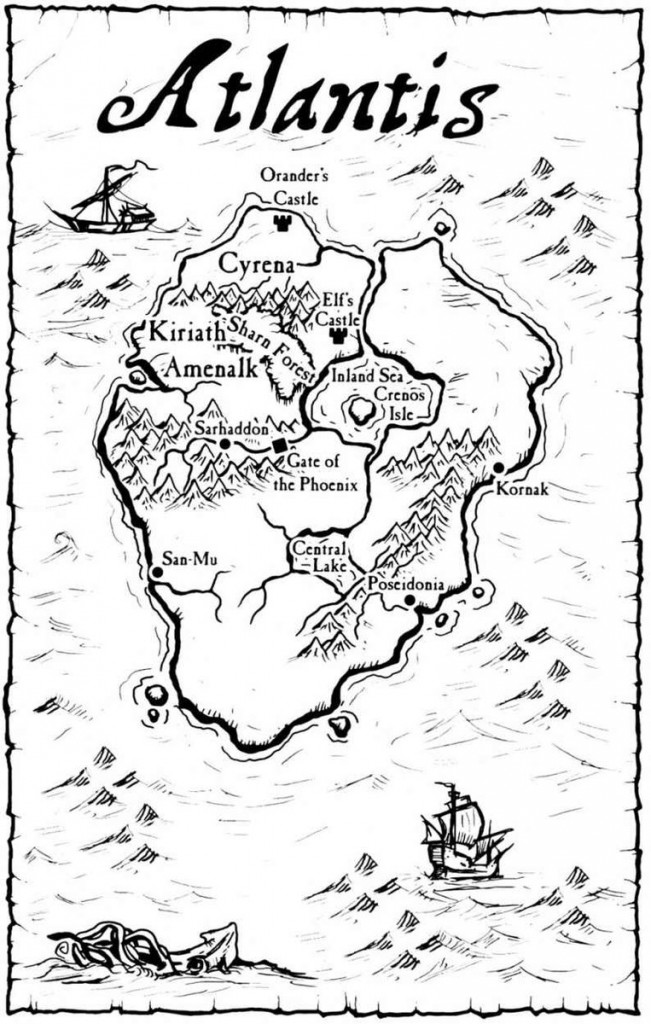
I read Kuttner’s Elak stories a few times before starting to write my own, to try and get a feel for his Atlantean world. I also made an early decision that Elak’s world is not only our world, but also that of Robert E Howard’s Kull, something that some purists won’t necessarily agree with. In my view it’s only the huge time span that separates the three. If Man has survived from the days of Kull, then so have the serpent men Kull fought – they appear in my first Elak story, “Blood of the Moon God,” and are almost certainly lurking about in the world of Nick Nightmare, my occult detective. (That’s a whole other box of tricks, but the creative principles in those alternative worlds are the same.)
As it happened, I’ve always been fascinated by Atlantis. I did write a novel about it, Storm Over Atlantis (a stand-alone and not related to Elak or any of my other work). So the opportunity to write more Elak stories and to explore his world was too good to pass up. I have tried to absorb all Kuttner’s Atlantean elements into my stories, even though, in some cases, his anachronisms are not easy to accept without maybe a grimace (Vikings, Picts, Druids, etc) but I am trying to integrate these and rationalize them as I go. I had the map of Atlantis to go on, so have been able to expand it with various islands, archipelagos and a whole continent in the longer novella “Sky Warriors of Atlantis” (the grand finale of King of Atlantis).
Generally, Kuttner made it easy for me to extend things as his 4 stories are closely knit and hint at a bigger picture. I think the important trick is to keep Kuttner’s characters and settings in mind at all times. Little things like Elak’s rapier. I did a bit of research, so that I know a bit more about the rapier as a weapon, and the first thing I discovered was that it isn’t an epee! Again, the whole thing is a question of balance. I won’t slavishly follow every nuance, or try to emulate Kuttner’s style, but I will try to keep the spirit and general feel of the originals. I hope the stories reflect the golden age of Weird Tales, as a tribute to its better elements. I’ve broken the individual stories into chapters, each with the kind of title you’d typically have found in Weird Tales, and make no apologies for some of the melodramatic titles, such as “Witch Queen Of Doom Island.”
You shouldn’t! That’s half the fun. For years, we ran a RPG set on the lost continent of Mu, and the one overarching rule was that every adventure had to have “xxx of Mu” for the title!
Of course, Elak is part of the Weird Tales milieu, and one of Kuttner’s stories was “The Spawn of Dagon,” which is clearly indebted to Howard’s initial King Kull story from 1929, “The Shadow Kingdom,” as well as to H.P. Lovecraft‘s “The Shadow Over Innsmouth” (1936). You’ve picked up those Mythos connections in your own expansions. Homage vs. pastiche vs. imitation is always a tricky balance – do you have any rules you set yourself for how much you’ll give a wink and a nod to your idols? How much do you feel your are continuing Kuttner’s work, versus using him as a spring-board? And since Kuttner was happy to use Lovecraft, should we expect to find Dalan matching wits with an avatar of Nyarlathotep?
Oh yes, I do love to pour everything in there! I mentioned Nick Nightmare and anyone who’s read his stories will immediately see the multiple crossovers and know that everything is fair game. I’m just as much a fan of HPL’s Mythos stories as anyone, and of course I am fusing Mythos stuff into the Elak saga – Kuttner already led the way, as you say. HPL loved having his weird universe expanded and so many of the WT gang joined in. I’m continuing that expansion, so you may well find Dalan up against an avatar of Nyarlathotep. As I write more of Elak, the saga will increasingly become my invention, but the vital factor for me is to keep Kuttner’s creations as the roots of the saga, so there will, I hope, always be a consistency about the characters and their world, even though I’m bringing in whole new regions. I’ve also got one eye on Howard’s Hyborian Age, which is an amazing background to all of these prehistoric eras.
Any ideas what’s next? Will Elak’s adventures continue, or is his Atlantis ready to slip back beneath the seas?
Well, over the years since I first wrote an Elak yarn, there have been a couple of times when I’ve assumed I’d come to the end of my extensions to the saga, but there’s been growing interest in the new material. I enjoy writing the stories and as long as there’s an appreciative audience, I will write more. I have a number of fresh ideas, so my own enthusiasm remains. Right now I’m writing a new story (working title “A Song of Pictish Kings”) which is the bridging story between the last Kuttner yarn, “Dragon’s Moon,” and my Elak saga. After that I’ll be doing “The Sleepers in The Stones,” which will be a longer novella, and once it’s done, there should be enough material to put together the second Elak book, Warrior of Atlantis. Ironically it fits in between Kuttner’s stories and King of Atlantis.
As for what’s in the new stories… lots of monsters, fighting, sorcery, Mythos (probably) and of course, the oceans at their most dangerous. And probably serpent men. And perhaps a bit more about REH’s Kathulos, the fiend, Skull Face. (I’ve already alluded to his Atlantis in “Hastur La Vista, Baby,” a Nick Nightmare yarn that appears in the latest volume of Stephen Jones’s Lovecraft Squad.)
I also have a couple of new Dream Lords stories to write, thus completing Dream Lords Legacy, the fourth book in that saga. And there are always new Nick Nightmare stories to write – he is a particularly demanding character. He keeps asking me when the heck am I going to write Nightmare in London, his novel. Now that is a weird one.
I can’t let this interview pass without making the following pitch… have you ever considered writing about a certain Puritan-adventurer from your corner of England? I mean, all the way back in the 70s, Zebra was using Robert E. Howard’s name to promote The Dream Lords, and now, 40+ years later, you’ve actually written a lot of sword & sorcery, have created an entire cycle of stories about the first character to follow in Conan’s footsteps, and known Devonshire rather well. I’m just saying….
I do refer to Devon as Solomon Kane country sometimes. I do enjoy the best of the Kane stories, but I don’t want to get too involved in other writers’ heroes! Mind you, it’s probably a case of never say never. And when I’m down on the local beach, I never know what’s going to come wandering along the sand…
About this photo, Adrian says: “Me, the book cover and an original interior illo
by the artist Jim Pitts, who has been illustrating my stuff since the 1970s”
Greg is a native Chicagoan with a background in journalism and history. While in university, he began researching the martial arts of Late Medieval and Renaissance Europe. After working in marketing and corporate communications for a decade, he lost his mind and opened a small, non-fiction press (www.freelanceacademypress.com) dedicated to medieval studies, and opened Chicago’s only full-time European martial arts school to house the Chicago Swordplay Guild, which he had founded in 1999 (www.chicagoswordplayguild.com). As a fiction writer, in recent years he has published a growing number of short stories, and has the obligatory unpublished novel manuscript sitting on his hard drive.
Greg lives with his very tolerant family in the Chicago suburbs. His most recent article for us was an Interview with Howard Andrew Jones.
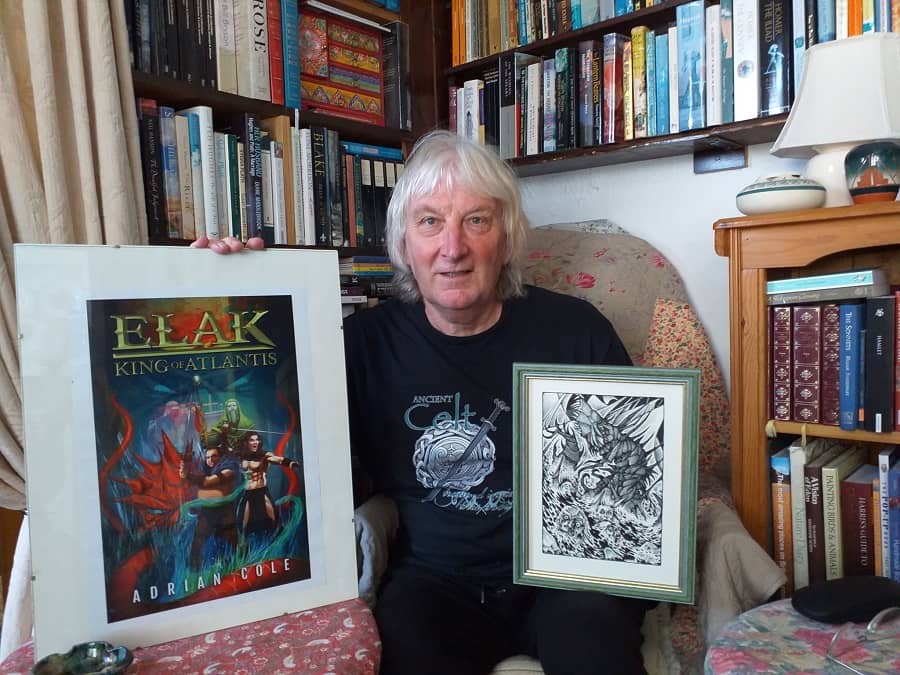
the Elak stories have been on my to read pile since Paizo reprinted them. Thankfully with you can still get a cheap ebook with the four stories (they are also on Hoopla.)
I’ll have to make time for them so i can read these newer ones.
I love the idea of keeping the story of Kull’s Atlantis going. I love Kull just as much as Conan.
“[Lin] even included me in one of his Year’s Best Fantasy volumes, praising my work.”
THAT was where I first read Adrian’s work–though I was aware of the Dream Lords books, I hadn’t read them. That volume of TYBF introduced me to Cole, Karl Edward Wagner and Charles Saunders. For that, I can’t thank Lin or Don Wollheim enough.
Deuce,
Right there is why, when folks like to bag on Lin Carter as a hack, I roll my eyes — as an editor he stands head and shoulders above most, and while he didn’t always write great fiction (although I’d argue he had some serious gems), he sure knew it when he saw it!
Congratulations, Adrian! Truly an excellent interview! I’ve been a fan of Elak since Lin Carter “introduced” me to him, and I just received my copy of your “Elak: King of Atlantis.” Looking forward to reading that one, and to the reissue of “The Dream Lords Trilogy.” Pulp Hero Press is on the march!